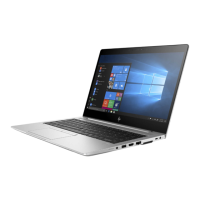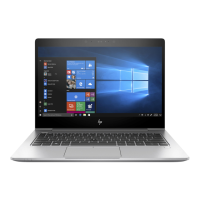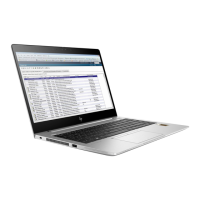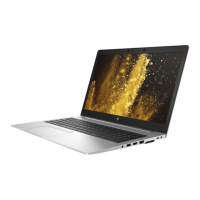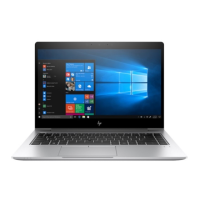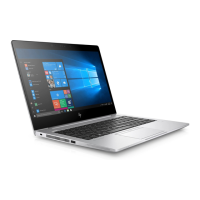Do you have a question about the HP EliteBook 745 G6 and is the answer not in the manual?
Details about the computer's processors, including model and specifications.
Information on graphics capabilities, including support for resolutions and multiple displays.
Specifications for the display panel, including size, resolution, and type.
Details on memory modules, including type, speed, and maximum supported capacity.
Specifications for M.2 solid-state drives, including capacity and interface type.
Information on Bluetooth and WLAN modules, including supported standards.
Specifications for battery and AC adapter, including wattage and type.
Security features like TPM, fingerprint reader, and smart card reader.
Details and identification of components located on the right side of the computer.
Details and identification of components located on the left side of the computer.
Identification and description of display-related components and features.
Details and identification of components within the keyboard area, including the touchpad.
Explanation of the various indicator lights on the computer and their meanings.
Identification and description of buttons, speakers, and fingerprint reader.
Explanation of special keys and hot keys and their functions.
Identification and description of components located on the bottom of the computer.
Identification and description of components located on the front of the computer.
Information about identifying labels on the computer for troubleshooting and support.
Lists and describes the main computer components and their spare part numbers.
Details and part numbers for individual components within the display assembly.
Information and part numbers for plastic components or kits.
Information and part numbers for various cables included in a kit.
Lists and describes various miscellaneous parts and their part numbers.
Lists the necessary tools for performing removal and replacement procedures.
Important considerations and precautions to follow during disassembly and assembly.
Information about electrostatic discharge (ESD) and its potential damage to components.
Guidelines for grounding methods, equipment, and workstation setup.
Guidelines for safely packaging and transporting equipment.
Steps to prepare the computer before starting disassembly for self-repair.
Procedure for removing and replacing the bottom cover.
Procedure for removing and replacing the Solid-State Drive (SSD).
Procedure for removing and replacing memory modules.
Procedure for removing and replacing the WLAN/Bluetooth combo card.
Procedure for removing and replacing the keyboard.
Procedure for removing and replacing the speaker assembly.
Procedure for removing and replacing the touchpad.
Procedure for removing and replacing the touchpad button board.
Procedure for removing and replacing the NFC module.
Procedure for removing and replacing the smart card reader.
Procedure for removing and replacing the system fan.
Procedure for removing and replacing the system board.
Procedure for removing and replacing the fingerprint reader assembly.
Procedures for removing and replacing the display assembly and its subcomponents.
Procedure for removing and replacing the top cover.
Table explaining front panel LEDs and audible codes for system status and errors.
Instructions on how to access and navigate the computer's BIOS/UEFI setup utility.
Information on how to update the system's BIOS version.
Information on configuring Trusted Platform Module (TPM) settings in BIOS.
Explanation of HP Sure Start technology for BIOS protection and recovery.
Guide to using the Windows-based hardware diagnostics tool.
Guide to using the UEFI-based hardware diagnostics tool for pre-boot diagnostics.
Information on configuring and using remote HP PC Hardware Diagnostics UEFI.
Procedures for backing up personal data and creating recovery media.
Overview of options for restoring the system from backups or recovery media.
How to modify the boot order to facilitate system recovery.
Explanation of HP Sure Recover for OS image restoration.
General specifications for the computer, including dimensions, weight, and operating conditions.
Detailed specifications for the 14.0-inch display panel.
Technical specifications for M.2 PCIe and SATA solid-state drives.
General requirements applicable to power cord sets in all regions.
Specific power cord requirements based on country and region.
Information on how nonvolatile memory is used and managed within the system.
Common questions and answers related to BIOS and memory.
| Operating System | Windows 10 Pro |
|---|---|
| Battery | 3-cell, 50 Wh Li-ion |
| Processor | AMD Ryzen 5 PRO 3500U |
| Graphics | AMD Radeon Vega 8 |
| Display | 14-inch FHD (1920 x 1080) |
| RAM | Up to 32GB DDR4 |
| Storage | 256GB PCIe NVMe SSD |
| Weight | 1.48 kg |
| Audio | dual stereo speakers |
| Wireless | Intel Wi-Fi 6 AX200, Bluetooth 5.0 |
| Ports | 2 x USB 3.1, 1 x USB-C, HDMI 1.4, headphone/microphone combo |

